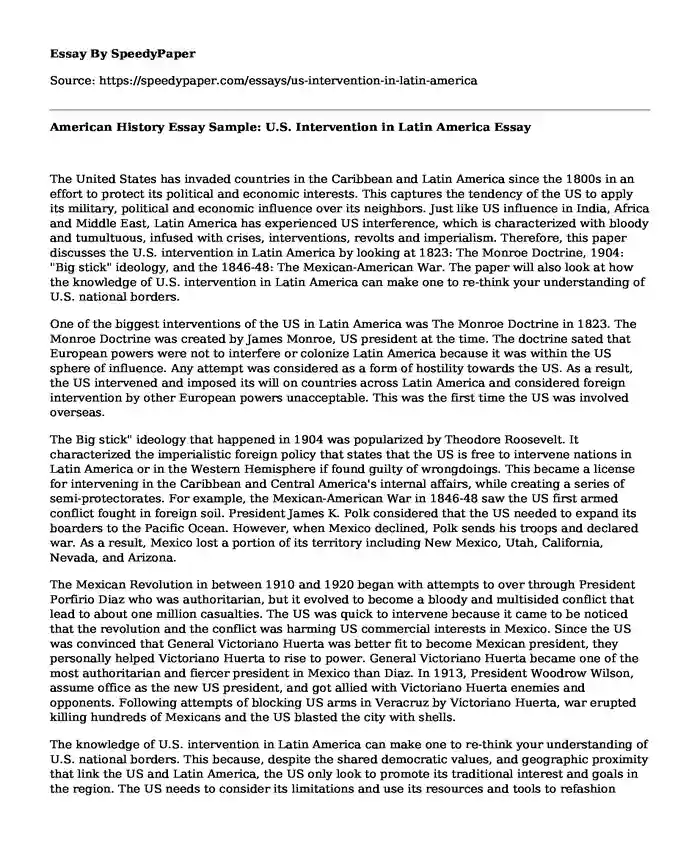
| Type of paper: | Essay |
| Categories: | War American history |
| Pages: | 3 |
| Wordcount: | 653 words |
The United States has invaded countries in the Caribbean and Latin America since the 1800s in an effort to protect its political and economic interests. This captures the tendency of the US to apply its military, political and economic influence over its neighbors. Just like US influence in India, Africa and Middle East, Latin America has experienced US interference, which is characterized with bloody and tumultuous, infused with crises, interventions, revolts and imperialism. Therefore, this paper discusses the U.S. intervention in Latin America by looking at 1823: The Monroe Doctrine, 1904: "Big stick" ideology, and the 1846-48: The Mexican-American War. The paper will also look at how the knowledge of U.S. intervention in Latin America can make one to re-think your understanding of U.S. national borders.
One of the biggest interventions of the US in Latin America was The Monroe Doctrine in 1823. The Monroe Doctrine was created by James Monroe, US president at the time. The doctrine sated that European powers were not to interfere or colonize Latin America because it was within the US sphere of influence. Any attempt was considered as a form of hostility towards the US. As a result, the US intervened and imposed its will on countries across Latin America and considered foreign intervention by other European powers unacceptable. This was the first time the US was involved overseas.
The Big stick" ideology that happened in 1904 was popularized by Theodore Roosevelt. It characterized the imperialistic foreign policy that states that the US is free to intervene nations in Latin America or in the Western Hemisphere if found guilty of wrongdoings. This became a license for intervening in the Caribbean and Central America's internal affairs, while creating a series of semi-protectorates. For example, the Mexican-American War in 1846-48 saw the US first armed conflict fought in foreign soil. President James K. Polk considered that the US needed to expand its boarders to the Pacific Ocean. However, when Mexico declined, Polk sends his troops and declared war. As a result, Mexico lost a portion of its territory including New Mexico, Utah, California, Nevada, and Arizona.
The Mexican Revolution in between 1910 and 1920 began with attempts to over through President Porfirio Diaz who was authoritarian, but it evolved to become a bloody and multisided conflict that lead to about one million casualties. The US was quick to intervene because it came to be noticed that the revolution and the conflict was harming US commercial interests in Mexico. Since the US was convinced that General Victoriano Huerta was better fit to become Mexican president, they personally helped Victoriano Huerta to rise to power. General Victoriano Huerta became one of the most authoritarian and fiercer president in Mexico than Diaz. In 1913, President Woodrow Wilson, assume office as the new US president, and got allied with Victoriano Huerta enemies and opponents. Following attempts of blocking US arms in Veracruz by Victoriano Huerta, war erupted killing hundreds of Mexicans and the US blasted the city with shells.
The knowledge of U.S. intervention in Latin America can make one to re-think your understanding of U.S. national borders. This because, despite the shared democratic values, and geographic proximity that link the US and Latin America, the US only look to promote its traditional interest and goals in the region. The US needs to consider its limitations and use its resources and tools to refashion Latin America's domestic economies and policies instead of targeting its resources. However, while targeting its resources, the US can help Latin America, while at the same time advancing its interests in prosperity and security of the region rather than interfering with its internal affairs.
References
Chomsky, N. (2015). Turning the tide: US intervention in Central America and the struggle for peace. Haymarket Books.
Thyne, C. L. (2010). Supporter of stability or agent of agitation? The effect of US foreign policy on coups in Latin America, 1960-99. Journal of Peace Research, 47(4), 449-461
Cite this page
American History Essay Sample: U.S. Intervention in Latin America. (2022, Sep 09). Retrieved from https://speedypaper.net/essays/us-intervention-in-latin-america
Request Removal
If you are the original author of this essay and no longer wish to have it published on the SpeedyPaper website, please click below to request its removal:
- Essay Example on Pagan and Christian Syncretism in the Dark/Middle Ages
- Creating Anglo-America - Free Essay in American History
- Essay Sample: The PICO Strategy for the Research Question
- Free Essay on the Economic Impact Of Cybercrime: At $600 Billion and Counting
- Essay Sample: Issues Affecting Addicts, their Families, and Society
- Essay Sample on Media Depictions and Eating Disorders
- Susie King Taylor's Account. Paper Example
Popular categories




